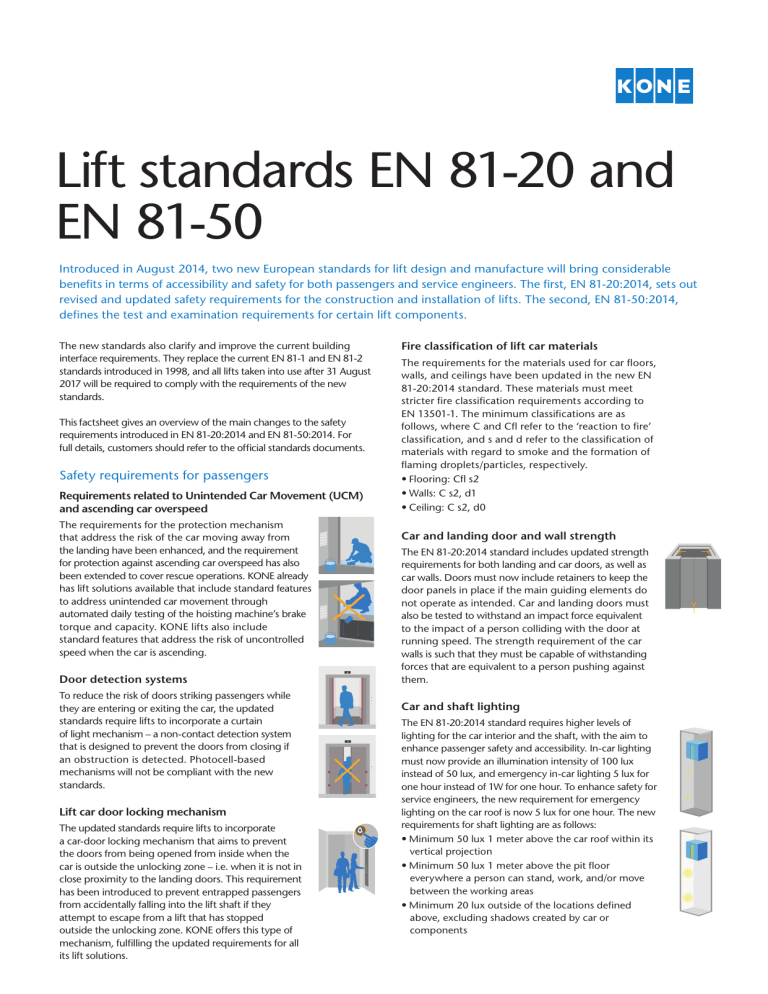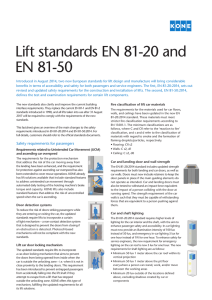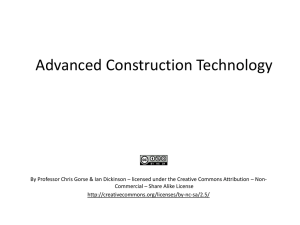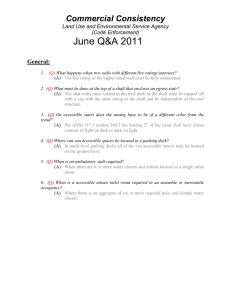
Lift standards EN 81-20 and EN 81-50 Introduced in August 2014, two new European standards for lift design and manufacture will bring considerable benefits in terms of accessibility and safety for both passengers and service engineers. The first, EN 81-20:2014, sets out revised and updated safety requirements for the construction and installation of lifts. The second, EN 81-50:2014, defines the test and examination requirements for certain lift components. The new standards also clarify and improve the current building interface requirements. They replace the current EN 81-1 and EN 81-2 standards introduced in 1998, and all lifts taken into use after 31 August 2017 will be required to comply with the requirements of the new standards. This factsheet gives an overview of the main changes to the safety requirements introduced in EN 81-20:2014 and EN 81-50:2014. For full details, customers should refer to the official standards documents. Safety requirements for passengers Requirements related to Unintended Car Movement (UCM) and ascending car overspeed The requirements for the protection mechanism that address the risk of the car moving away from the landing have been enhanced, and the requirement for protection against ascending car overspeed has also been extended to cover rescue operations. KONE already has lift solutions available that include standard features to address unintended car movement through automated daily testing of the hoisting machine’s brake torque and capacity. KONE lifts also include standard features that address the risk of uncontrolled speed when the car is ascending. Door detection systems To reduce the risk of doors striking passengers while they are entering or exiting the car, the updated standards require lifts to incorporate a curtain of light mechanism – a non-contact detection system that is designed to prevent the doors from closing if an obstruction is detected. Photocell-based mechanisms will not be compliant with the new standards. Lift car door locking mechanism The updated standards require lifts to incorporate a car-door locking mechanism that aims to prevent the doors from being opened from inside when the car is outside the unlocking zone – i.e. when it is not in close proximity to the landing doors. This requirement has been introduced to prevent entrapped passengers from accidentally falling into the lift shaft if they attempt to escape from a lift that has stopped outside the unlocking zone. KONE offers this type of mechanism, fulfilling the updated requirements for all its lift solutions. Fire classification of lift car materials The requirements for the materials used for car floors, walls, and ceilings have been updated in the new EN 81-20:2014 standard. These materials must meet stricter fire classification requirements according to EN 13501-1. The minimum classifications are as follows, where C and Cfl refer to the ‘reaction to fire’ classification, and s and d refer to the classification of materials with regard to smoke and the formation of flaming droplets/particles, respectively. • Flooring: Cfl s2 • Walls: C s2, d1 • Ceiling: C s2, d0 Car and landing door and wall strength The EN 81-20:2014 standard includes updated strength requirements for both landing and car doors, as well as car walls. Doors must now include retainers to keep the door panels in place if the main guiding elements do not operate as intended. Car and landing doors must also be tested to withstand an impact force equivalent to the impact of a person colliding with the door at running speed. The strength requirement of the car walls is such that they must be capable of withstanding forces that are equivalent to a person pushing against them. Car and shaft lighting The EN 81-20:2014 standard requires higher levels of lighting for the car interior and the shaft, with the aim to enhance passenger safety and accessibility. In-car lighting must now provide an illumination intensity of 100 lux instead of 50 lux, and emergency in-car lighting 5 lux for one hour instead of 1W for one hour. To enhance safety for service engineers, the new requirement for emergency lighting on the car roof is now 5 lux for one hour. The new requirements for shaft lighting are as follows: • Minimum 50 lux 1 meter above the car roof within its vertical projection • Minimum 50 lux 1 meter above the pit floor everywhere a person can stand, work, and/or move between the working areas • Minimum 20 lux outside of the locations defined above, excluding shadows created by car or components Safety requirements for service engineers Car roof balustrades Pit and machine-room access, and control-station location Balustrades located on the lift car roof now have defined strength requirements and updated height requirements. These new requirements have been introduced to reduce the risk of engineers falling into the shaft while working on the car roof. The new requirements are as follows: The EN 81-20 :2014 standard introduces a number of requirements that aim to make accessing the lift machine room and working in the pit safer for service engineers. Access aids such as ladders now have defined dimension, strength, and location requirements. The access requirements for pits deeper than 2.5 m are now stricter, and an access door may be required. The standard also requires a control station to be located in the pit, to prevent engineers from having to use ladders or stools in order to reach the components under the car. The control station must be located near the pit’s refuge spaces. There must also be a reset function outside the shaft. Access, inspection, and rescue doors, and counterweight safety gear The EN 81-20:2014 standard requires access or inspection doors instead of inspection “trapdoors” to address safe and easy access for engineers. The new requirements are as follows: • Machine-room and shaft access doors shall have a minimum height of 2 m and a minimum width of 0.6 m. • Pulley-room access doors shall have a minimum height of 1.4 m and a minimum width of 0.6 m. • Access trapdoors for engineers to machine and pulley rooms shall give a clear passage of at least 0.8 m x 0.8 m and shall be counterbalanced. • Emergency doors shall have a minimum height of 1.8 m and a minimum width of 0.5 m. • Inspection doors shall have a maximum height and width of 0.5 m. The new standard also requires the counterweight to be fitted with a safety gear in cases where there are accessible spaces under the pit – for example, where the pit is located above a parking garage or basement storage space. Car roof and pit refuge spaces The volume requirements for the safety refuge spaces on the car roof and in the pit have been increased. The new volumes are as follows: • Upright position: 0.4 x 0.5 m (horizontal dimensions), 2 m (height) • Crouching position: 0.5 x 0.7 m (horizontal dimensions), 1 m (height) • Laying position: 0.7 x 1.0 m (horizontal dimensions), 0.5 m (height) for pit only The EN 81-20:2014 standard now requires that the landing door providing access to the pit must be able to be opened from the shaft so that engineers can exit the lift shaft, even if the relevant landing door would be closed. • Where the distance between the inner edge of the balustrade handrail and the shaft wall is up to 500 mm, the balustrade must have a minimum height of 700 mm. • Where the distance between the inner edge of the balustrade handrail and the shaft wall exceeds 500 mm the balustrade must have a minimum height of 1100 mm Horizontal projection into the shaft Any horizontal projection (ledge) from a wall into the shaft, or horizontal beam greater than 150 mm wide – including separator beams – must be protected so that a person cannot stand on it, except when access is prevented by a balustrade on the car roof that meets the requirements stated above. This exception does not apply for ledges around the pit, for example with a partially enclosed lift shaft. Changes affecting building design The EN 81-20:2014 standard introduces some changes to the requirements that the building designer is required to fulfill. These changes all apply to the lift shaft, and are as follows: • All glass used in the lift shaft must be laminated. • Shaft walls to withstand 1000N • Shaft ventilation is now the responsibility of the building designer. The lift manufacturer must provide all the necessary information about, for example, the heat emissions of lift components. This approach facilitates energy- efficient building design, where ventilation requirements are determined based on the most energy-efficient solution, while at the same time taking into account working conditions for engineers working in the lift shaft, and the comfort of passengers inside the car. • A fire extinguisher can be located in the shaft. Activation of the sprinkler shall only be possible, when the lift is stationary at a landing and the main switches of the lift and lighting circuits are automatically switched off by the fire or smoke detection system. More information For full details of the new standards, customers should refer to the official EN 81-20:2014 (E) and EN 81-50:2014 (E) standards documents. Please contact your local KONE salesperson for more information. KONE Plc www.kone.co.uk This publication is for general informational purposes only and we reserve the right at any time to alter the product design and specifications. No statement this publication contains shall be construed as a warranty or condition, express or implied, as to any product, its fitness for any particular purpose, merchantability, quality or representation of the terms of any purchase agreement. Minor differences between printed and actual colours may exist. KONE MonoSpace ®, KONE EcoDisc®, KONE Care ® and People Flow® are registered trademarks of KONE Corporation. 8041/NOV/2015 Copyright © 2015 KONE Corporation. Information correct at the time of production.


